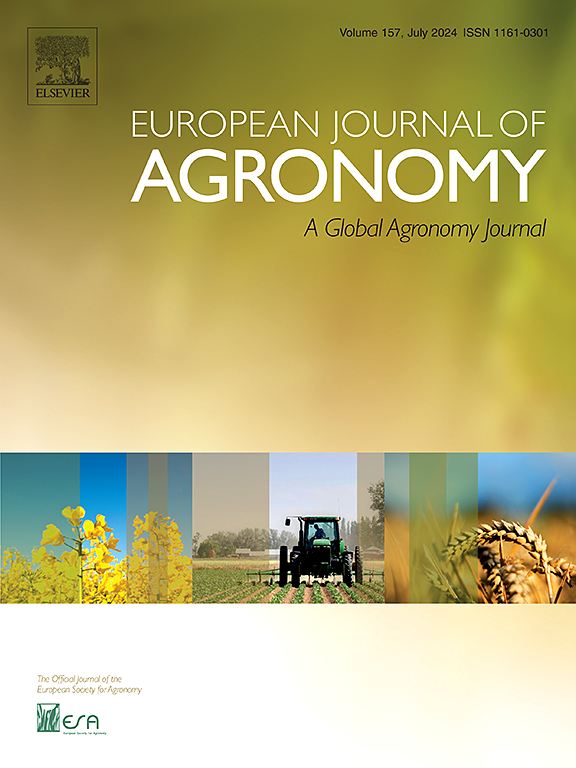优化灌溉覆盖策略改善黄土高原苹果-大豆旱作系统根水关系、水分利用效率和产量
IF 4.5
1区 农林科学
Q1 AGRONOMY
引用次数: 0
摘要
陕西北黄土高原苹果-大豆小巷种植系统(ASCS)果实成熟后的产量受到水资源短缺和种间竞争的威胁。横向滴灌方式精确灌溉的种间水分利用研究有限。一项为期3年的研究评估了三种滴灌器间距(L1:每行大豆一行;L2:每两行一个;L3(每3行1株)与覆盖(M1)和不覆盖(M0)组合对ASCS土壤含水量(SWC)、根系分布、籽粒产量(GY)和水分利用效率(WUE)的影响。另外,还包括两个非灌溉对照处理:CK1(覆盖)和CK0(不覆盖)。结果表明:覆盖增加了0 ~ 60 cm层的SWC(23.59 %)和根长密度(49.01 %),同时增加了耗水量;而在非灌溉(CK1)条件下,它缓解了干旱造成的有害水分竞争。在间作系统中,较窄的1级灌水器间距和较宽的3级灌水器间距表现出相反的水分分布模式,都限制了根系的生长。值得注意的是,与L1相比,L3使大豆RLD降低了56.35 %。最佳滴灌间距L2形成了干湿交替区,提高了土壤水势梯度。这种分布促进了相反的根系扩张,减轻了生长季节对水分吸收的竞争。在非覆盖处理中,L1的WUE和GY最高,比其他非覆盖处理提高60.17 %。在覆盖处理中,与未覆盖的L2处理相比,L2处理的GY和WUE分别提高了56.32 %和46.78 %。因此,建议在3 - 6年黄豆中,无覆盖条件下每行1根灌水线,覆盖条件下每两行1根灌水线,以优化根系水分分配,提高产量。本文章由计算机程序翻译,如有差异,请以英文原文为准。
Optimizing irrigation and mulching strategies to improve root–water relations, water use efficiency, and yield in apple–soybean alley cropping systems on the Loess Plateau, China
The productivity of young apple-soybean alley cropping systems (ASCS) in the Loess Plateau of northwestern Shanxi, China, is threatened by water scarcity and interspecific competition as fruit trees mature. Research on interspecies water utilization in precision irrigation with lateral drip line layouts is limited. A 3-year study evaluated the effects of three drip emitter spacings (L1: one line per soybean row; L2: one every two rows; L3: one every three rows) combined with mulching (M1) and non-mulching (M0) on soil water content (SWC), root distribution, grain yield (GY), and water-use efficiency (WUE) in ASCS. Additionally, two non-irrigated control treatments were included: CK1 (mulching) and CK0 (non-mulching). The results showed that mulching increased SWC (23.59 %) and root length density (RLD) (49.01 %) in the 0–60 cm layer, accompanied by higher water consumption. However, it alleviated the detrimental water competition caused by drought under non-irrigated (CK1) conditions. The narrow L1 and wide L3 emitter spacings exhibited opposing moisture distribution patterns, both restricting root growth in the intercropping system. Notably, L3 reduced soybean RLD by 56.35 % compared to L1. In contrast, the optimal drip spacing L2 created alternating wet and dry zones, enhancing the soil water potential gradient. This distribution promoted opposing root expansion and mitigated competition for water absorption over the growing seasons. Among non-mulched treatments, L1 achieved the highest WUE and GY, increasing by 60.17 % over other non-mulched treatments. In mulched treatments, L2 maximized GY and WUE, increasing by 56.32 % and 46.78 %, respectively, compared to non-mulched L2 treatment. Therefore, one emitter line per soybean row under non-mulched conditions and one per two rows under mulched conditions in 3–6-year-old ASCS is recommended to optimize root-water distribution and improve productivity.
求助全文
通过发布文献求助,成功后即可免费获取论文全文。
去求助
来源期刊

European Journal of Agronomy
农林科学-农艺学
CiteScore
8.30
自引率
7.70%
发文量
187
审稿时长
4.5 months
期刊介绍:
The European Journal of Agronomy, the official journal of the European Society for Agronomy, publishes original research papers reporting experimental and theoretical contributions to field-based agronomy and crop science. The journal will consider research at the field level for agricultural, horticultural and tree crops, that uses comprehensive and explanatory approaches. The EJA covers the following topics:
crop physiology
crop production and management including irrigation, fertilization and soil management
agroclimatology and modelling
plant-soil relationships
crop quality and post-harvest physiology
farming and cropping systems
agroecosystems and the environment
crop-weed interactions and management
organic farming
horticultural crops
papers from the European Society for Agronomy bi-annual meetings
In determining the suitability of submitted articles for publication, particular scrutiny is placed on the degree of novelty and significance of the research and the extent to which it adds to existing knowledge in agronomy.
 求助内容:
求助内容: 应助结果提醒方式:
应助结果提醒方式:


